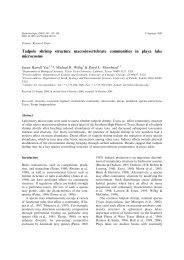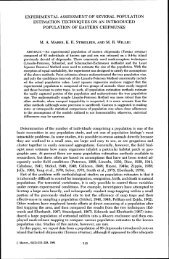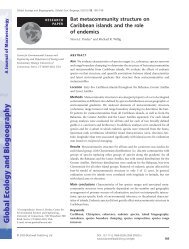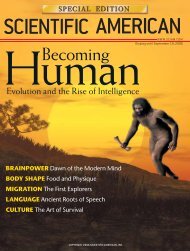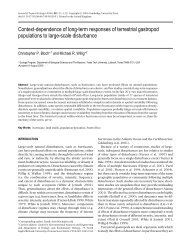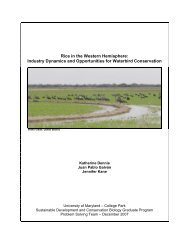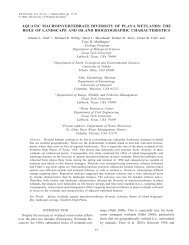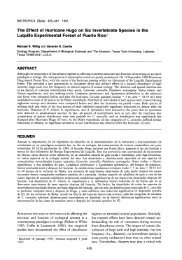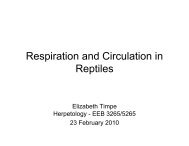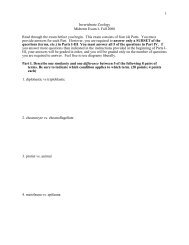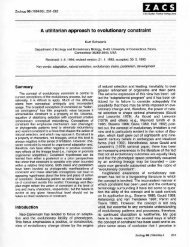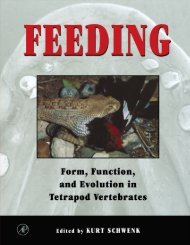Comparative biology and the importance of cladistic classification: a ...
Comparative biology and the importance of cladistic classification: a ...
Comparative biology and the importance of cladistic classification: a ...
Create successful ePaper yourself
Turn your PDF publications into a flip-book with our unique Google optimized e-Paper software.
CLADISTIC CLASSIFICATION 77<br />
out gekkonids as exceptions, noting that, though ascalabotans, <strong>the</strong>y are<br />
never<strong>the</strong>less highly chemosensory. Despite <strong>the</strong>se cautionary statements, most<br />
subsequent studies fail to mention <strong>the</strong>m, relying primarily on previous reviews.<br />
For example, Bogert & Martin del Campo (1956: 103) reiterated Underwood’s<br />
(1951) statement (but without noting exceptions). Madison (1977: 150) relied<br />
heavily on Evans’ (1961, 1967) generalizations: “An excellent review by Evans<br />
(1961), <strong>and</strong> a subsequent update (Evans, 1965 [sic]), form a good starting point<br />
for a consideration <strong>of</strong> chemical communication in <strong>the</strong> lizards.” Underwood<br />
(1971: viii-ix) made one <strong>of</strong> <strong>the</strong> most all-inclusive statements linking Camp’s<br />
(1923) divisions to sensory mode <strong>and</strong> many o<strong>the</strong>r aspects <strong>of</strong> squamate <strong>biology</strong>,<br />
including tongue form, direction <strong>of</strong> evolutionary transformation, terrestrial vs.<br />
aquatic habitats, sexual dimorphism <strong>and</strong> dichromatism, <strong>and</strong> pituitary<br />
development. He concluded with <strong>the</strong> assertion quoted at <strong>the</strong> beginning <strong>of</strong> this<br />
paper, that Camp’s (1923) divisions has passed <strong>the</strong> test <strong>of</strong> <strong>classification</strong>; <strong>the</strong>y<br />
have predictive power. Underwood’s (1971) paper was published as an<br />
introduction to a reprint <strong>of</strong> Camp’s (1923) monograph <strong>and</strong> this juxtaposition<br />
with Camp’s <strong>classification</strong> makes it a particularly powerful statement. More<br />
recently, Simon (1983: 129-1 30) stated <strong>the</strong> dichotomy clearly:<br />
The <strong>importance</strong> <strong>of</strong> <strong>the</strong> vomeronasal system varies somewhat with taxonomic affinities<br />
<strong>of</strong> lizards. Camp (1923) divided lizards into two major groups, <strong>the</strong> ascalabotans<br />
(Chamaeleonidae, Agamidae, Iguanidae, Gekkonidae <strong>and</strong> Xantusiidae) <strong>and</strong> <strong>the</strong><br />
autarchoglossans (Lacertidae, Scincidae, Teiidae, Cordylidae, Helodermatidae,<br />
Varanidae <strong>and</strong> all o<strong>the</strong>r lizard families). . . . The ascalabotans seem to rely most<br />
heavily upon vision, whereas most autarchoglossans use both vision <strong>and</strong><br />
chemoreception (Camp, 1923; Evans, 196 1, 1967; Underwood, 1970; Bissinger &<br />
Simon, 1979; Duvall, 1980; Duvall, Herskowitz & Trupiano-Duvall, 1980).<br />
In a recent <strong>and</strong> thorough review, Halpern (1992: 426) reiterated Simon’s (1983)<br />
phylogenetic conclusions.<br />
Although I have focused on influential reviews above, <strong>the</strong> same problem is<br />
repeated in <strong>the</strong> primary literature. Once established in <strong>the</strong> literature, <strong>the</strong><br />
dichotomy <strong>of</strong> a visual Ascalabota <strong>and</strong> a chemosensory Autarchoglossa quickly<br />
became <strong>the</strong> organizing evolutionary framework within which authors<br />
interpreted <strong>the</strong>ir studies (e.g. Underwood, 1970; Stamps, 1977; Bissinger &<br />
Simon, 1979; Duvall et al., 1980; Duvall, 1981; Cooper, 1981, 1989a, 1989b,<br />
1990a; Nicoletto, 1985; Simon & Moakley, 1985; Mason & Gutzke, 1990).<br />
While information decay is certainly not an outcome peculiar to paraphyletic<br />
<strong>classification</strong>s, <strong>the</strong>re is likely to be a certain sensitivity to starting conditions.<br />
A <strong>cladistic</strong> <strong>classification</strong> might have mitigated <strong>the</strong> effects <strong>of</strong> this decay by<br />
providing a more accurate starting point <strong>and</strong> by eliminating at <strong>the</strong> outset some<br />
<strong>of</strong> <strong>the</strong> taxonomic exceptions required by early workers. In any case, <strong>the</strong> salient<br />
result <strong>of</strong> this process was a poorly supported dogma <strong>and</strong> eventually, confusion.<br />
Con fusion<br />
Several factors have conspired to create confusion regarding <strong>the</strong> evolution <strong>of</strong><br />
sensory systems in Squamata. First, as noted above, <strong>the</strong> original formulators <strong>of</strong><br />
<strong>the</strong> generalizations under discussion here, as well as many subsequent workers,<br />
have noted exceptions <strong>and</strong> qualifications, but <strong>the</strong>se have been only sporadically



